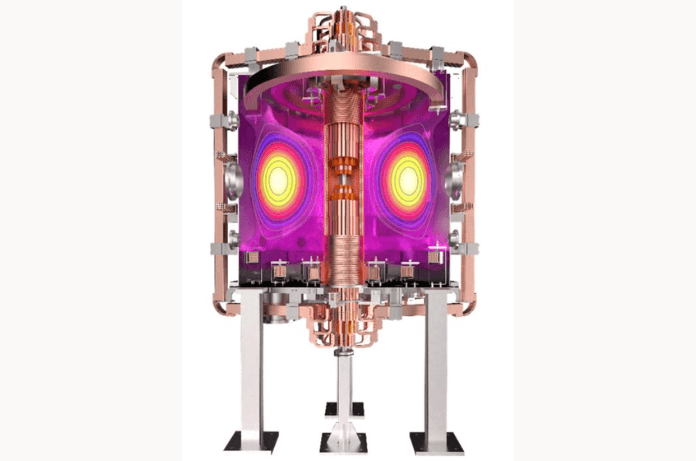Nuclear fusion has long been considered the holy grail of clean, sustainable, and nearly infinite energy. Now, a groundbreaking achievement by the Small Aspect Ratio Tokamak (SMART) has brought us closer to making this dream a reality. With its first successful plasma, SMART has set the stage for a future where compact fusion power plants could transform how we power our world.
What Is Nuclear Fusion and Why Does It Matter?
Nuclear fusion mimics the energy production process of our sun. The process involves fusing two light atomic nuclei into a heavier nucleus, releasing vast amounts of energy in the process. This is the same reaction that powers the sun and other stars. So, nuclear fusion reactors are often termed as ‘artificial sun’. Unlike nuclear fission, which splits atomic nuclei and produces hazardous radioactive waste, nuclear fusion is cleaner and safer, leaving no long-lasting waste behind.
However, replicating the sun’s conditions on Earth isn’t easy. Sun relies on its immense gravitational pressure. Fusion reactors on Earth must achieve temperatures much hotter than the sun’s core to compensate for the lower pressure. The result is plasma, a high-energy fourth state of matter, confined within a tokamak.
Meet SMART: The Revolutionary Tokamak
The Small Aspect Ratio Tokamak is an experimental device designed, developed, and operated by the University of Seville’s Plasma Science and Fusion Technology Laboratory. SMART is a unique device leading the way in compact fusion power technology. Unlike traditional tokamaks, this device employs a revolutionary plasma shaping technique called negative triangularity, which enhances its performance.
In most tokamaks, plasma takes on a D-like shape with positive triangularity, but SMART flips this concept, creating a mirrored D shape. Why does this matter? Because of negative triangularity:
- Reduces instabilities that could eject particles and energy from the plasma.
- Protects the tokamak walls from severe damage.
- Offers better heat management, distributing the heat more evenly over a larger diverter area.
This makes SMART not only efficient but also more practical for designing compact fusion power plants.
A Historic Achievement of SMART Device
On January 20, 2025, SMART successfully produced its “first plasma”. This milestone marks the beginning of its operational phase. According to Prof. Manuel Garcia Munoz, Principal Investigator of SMART, “This is a significant accomplishment for the entire team. With its appealing fusion performance and power management, SMART has the potential to revolutionize the field.”
Prof. Eleonora Viezzer, Co-Principal Investigator of the SMART project, echoed enthusiasm: “We are thrilled to see the first magnetically confined plasma, with high anticipation surrounding the potential of the SMART device. All are looking forward to studying the capabilities of the SMART device together with the international scientific community and exploring its full potential.”
Why Negative Triangularity Matters
Negative triangularity is more than a novel concept and it’s a game-changer. By reshaping the plasma, SMART achieves:
- Enhanced stability: Preventing energy loss and maintaining a steady plasma state.
- Better power handling: Making it easier to manage the heat exhaust.
- Simpler engineering: Aiding in the design of smaller, more efficient fusion power plants.
These advantages make SMART the first device capable of combining negative triangularity with high-field spherical tokamaks, paving the way for Fusion2Grid, a global initiative to create the most efficient fusion power plants possible.
Global Collaboration and Impact
The success of SMART has drawn significant attention from the international fusion community. It is the first step in the Fusion2Grid strategy, which aims to develop the smallest and most efficient fusion power plants. By working with scientists worldwide, the SMART team is laying the foundation for real-world applications of fusion energy.
This achievement also builds on the success of the Experimental Advanced Superconducting Tokamak (EAST) in China. On the same day SMART achieved its first plasma, EAST set a new record by maintaining plasma for 1,066 seconds at 100 million degrees Celsius, more than doubling its previous best. These breakthroughs highlight the global momentum toward achieving sustainable fusion energy.
A Brighter Future with SMART
As Prof. Garcia Munoz puts it, “The future is full of wonderful things.” SMART’s long-term goal is ambitious yet achievable: to design a fusion power plant that is not only efficient but also compact enough for widespread use. This solenoid-driven plasma milestone is a critical step in that direction. The SMART team is optimistic about the future, as their innovative device is uniquely positioned to make fusion energy accessible on a global scale.
Fusion energy isn’t just about powering the grid and it’s about securing our planet’s future. As the demand for clean energy grows, devices like SMART offer a solution that is both sustainable and scalable. Unlike traditional energy sources, fusion produces no greenhouse gases, has minimal environmental impact, and offers a virtually limitless supply of energy.
SMART’s first plasma is more than just a scientific achievement and it’s a beacon of hope in the quest for clean energy. The success of SMART is a testament to human creativity and the power of global collaboration. With its revolutionary design and international collaboration, the SMART device is lighting the way to a brighter, more sustainable future.

